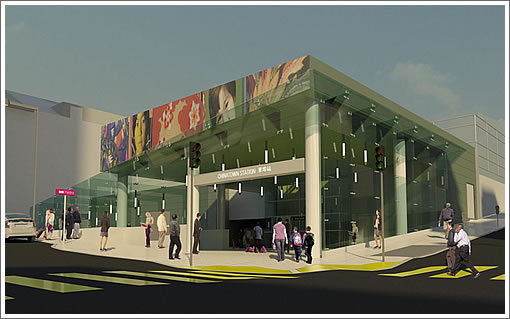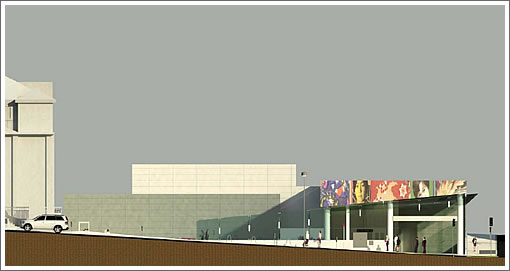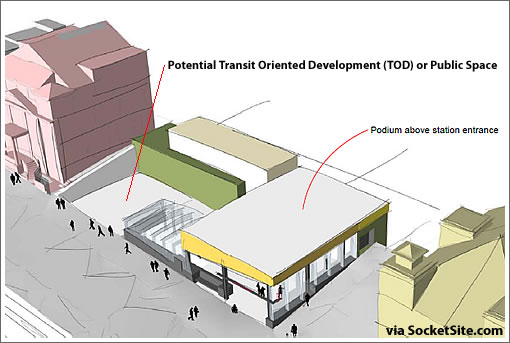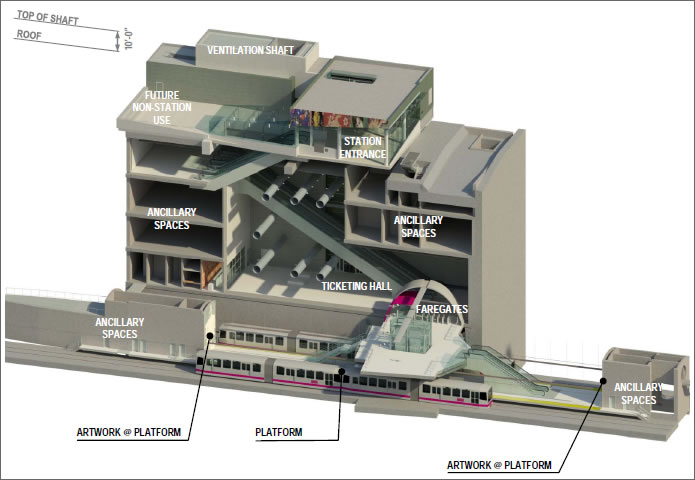
While the site has long been secured, and the demolition of the two-story building which sits upon the site of San Francisco’s future Central Subway Chinatown Station authorized, the design for the station has yet to be approved and is scheduled to be presented to San Francisco’s Planning Commission next week.
The majority of the proposed station will be located underground and is not subject to Commission review. At the street level, however, the project includes construction of a one-story station entrance building, known as the “head house,” containing the station entrance and exits, an enclosed glass skylight that illuminates the escalators, back-of-house circulation and mechanical features, and an open plaza at the south end of the site:

The proposed building is composed as a three part scheme including a base, glazed body, and a top/fascia element. A public art installation, which has been approved by the Arts Commission, will wrap around the building at the cornice level. The top of the head house (approximately 24 feet above the sidewalk at the corner) is a flat slab capable of supporting future Transit Oriented Development (TOD) or a public park/open space.

Planning is charged with returning to the Planning Commission within a year of the station’s design being authorized with a plan and proposal for the slab. The Central Subway Summer Newsletter contains an update on all the subway laboring to date.

Here’s hoping for transit-oriented development and NOT a public park/open space.
I realize there’s not the same neighborhood dynamic and this’ll be a different agency’s station, but the the two street-level plazas at the 16th and Mission street BART station smell like urinals due to human waste and other debris deposited there daily by derelict homeless people:
Emphasis mine.
Assuming that the infamous Lanterman-Petris-Short Act will still be in effect when this station gets built, and that therefore even more crazies will be living on the street passively causing mayhem, it’s better to not create another public place where they can loiterer and practice public urination.
Chinatown is a very different environment from the Mission and this space has a very different configuration than a corner lot.
if they were smart they would add 10 floors of residential on top of the station…
Let’s be real, for the most part the public and users in the Chinatown area are far more civilized than the homeless and druggies who hang out at the Bart Stations along Mission St.
Or at least replace some of the dozen or so storefronts that are being demolished.
The ‘mural’ feature on top looks really lame, like an applique advertisement from a muni bus. Hmmm.
They should have just gne with a pagoda…
a. agree we should stack residences on top – this town needs housing, especially in chinatown
b. agree the design is completely ignorant of the reality of sf urban life. all that glass will be scratched and acid-scarred within weeks of install. homeless folks will migrate to wherever a warm dry station is built. and the mural already looks dated.
what is so hard about a timeless design and materials that will wear well??
I was in Sydney, Australia a few months ago on vacation, and we used their transit system to get around the entire city: very easy, very clean, and on time.
The stations were immaculate, open, clean, no graffiti, no homeless, no etched glass. You know why?
Because Sydney is remarkably civil society, and they do NOT tolerate, or put up with the homeless/druggie bs, on the streets, that we do in our fair city. They have amazing programs to help and support those in need.
Stop trying to make open spaces near transit stations. Just build on top of them like the rest of the world. No one other than the junkies and the crazies want to hang out in them.
“They have amazing programs to help and support those in need.”
They can’t possibly be better than those in San Francisco – because SF spends 10x per homeless individual what Sydney does.
Impossible to think our homeless program resources are being squandered in SF.
It looks like an entrance to a library. Don’t like it.
79sh where do you get your figures? I guess it more about how you spend it…
Govt subsidized per ride cost must be at least $50 dollars a rider over 100 years after fare collection.
The cost depends heavily on the interest rate that must be paid to sell the bonds, as well as the rate of depreciation (beyond maintenance).
As a base scenario, suppose that the asset depreciates at 1% per year. Maintenance costs start at 4 million and increase by 2% (inflation. The project is financed with 5% bonds and costs 1.6 Billion.
Then in year 1, we will be getting 7.5 million miles of rides per year at a cost of $100 million in year 0, and by the time year 100 rolls around, those 7.5 million mile rides will cost us $124 million. So the cost per mile-ride starts at $13 and goes up to $16. How much is paid for by faires and how much by the city is a separate issue.
But from the point of view of the city, the Feds are kicking in 1 Billion, so the cost per ride falls to about $5 in year 0 and increase to about $9 in year 100, which is a lot more palatable.
In terms of real resources, we shouldn’t pretend that something financed by the government is free. On the other hand, the government can sell 10 year bonds for 1.6%, whereas the city can’t. If the whole project is financed for 2/3 at 1.6% and 1/3 at 5%, then the arithmetic changes a lot, and the cost per ride starts around $6 and goes to around $9 again.
Not the best use of the city’s funds, but not horrible, either.
Govt subsidized per ride cost must be at least $50 dollars a rider over 100 years after fare collection. People complain on this site about cost of road construction but this subway line to nowhere really shows why transit planning gets ruined by politics. The fact that there is no line connecting the western or northern neighborhoods , yet this gets built first is a true shame. Rail transit is not cheap and can only operate with taxpayer assistance, so why not connect half the population of the city that has no rapid RAPID transit alternatives to slow SLOW bus service or cars.
Nobody is going to ride this turd. Look at the epic escalator. You all know how often the existing, much shorter Muni escalators are out of service, right? You think those creaky old chinatown ladies are going to walk up 700 feet of stairs to get to the street level? Even when it is working it will take a ridiculously long time to get from platform to street.
Is there only one entrance to this subway station? Only one elevator?
“The ‘mural’ feature on top looks really lame, like an applique advertisement from a muni bus. Hmmm.”
My guess is that this is only an image placeholder for planning. SFPA has a whole different process for finding artists. I know that they’ve been actively searching for a number of projects relating to the central subway as well as SF airport expansion.
Personally, I think this structure design lends itself to a bolder, simpler image, perhaps a tile mosaic using Asian tiles and colors.
Put residential and street commercial on top, keep the area dense. And figure how to build the world’s first “flush escalator” to keep the mechanism from getting gummed up.
Please, let’s not repeat the mistakes of the past. The escalators should be behind doors so folks can’t access them when the station is closed and should be completely covered so they are not rained on.
And I agree that there should be housing above this station.
I may be hated for suggesting this, but i was part of the team involved in the partnership between Apple and the Chicago CTA Red Line Subway station refurbishment that included a new public plaza. Apple gave 3.9 million to assist the over 70 year old station get a much needed facelift, as well as providing a new public space adjacent to the apple retail store serving the Lincoln Park neighborhood.
Now the Chinatown station looks great, but there are opportunities out there to use private money as well.
http://arcchicago.blogspot.com/2010/10/apple-mania-descends-on-north-avenue-as.html
Morgan,
The government is often the best source of funding for public interest project. Budgets have to be respected, I agree, but there’s no substitute for the government as a line of the defense of common interest, when properly done. There’s always something unforeseen, an extra cost that will put you over budget. An obtuse budget-obsessed committee could botch a project.
Robert,
A 100 year projection? Heck, if the Paris subway had thought of doing a 100 year plan they would never have built their Metro. In 100 years they’ve gone through 2 world wars, 3 currencies, 10000%+ inflation, 2 major colonial wars, 4 constitutions. Even in a much more stable country, looking ahead financially more than 20 years is futile.
The key is that every city that has built a subway system thanks its predecessors for it. We should be cranking out line after line all across SF.
Seriously, can the nay-sayers to point to even one underground transit system that is not widely appreciated by its residents?
Chinatown was an obvious place to send a subway, despite all the naysayers. Here’s a pretty good population density map of the City: http://www.uncanny.net/~wetzel/sfdensity.htm
Chinatown/North Beach is, along with the TL and the Inner Mission, the most densely populated area of the city. The latter two areas are fairly well served by underground transport (Bart and Muni), so Chinatown was a great choice for sending a line.
The next priorities should be the long awaited infill BART station at 30th Street, and, maybe, a Muni line out to the Richmond? Along or under Geary? Plus finishing out this Chinatown line all the way to the Marina.
Just want to remind everyone that “underground” does not equal “higher capacity” or “faster”.
I’m a naysayer for this particular project precisely because this project is going to be too slow and with a pathetically low capacity. It’s going to end up siphoning away resources from other places that need it more, without improving service along its route.
(and yes, I’m extremely pro-transit and wish we were spending $5 billion a year building subways all over the city, just not this bloated transit-industrial complex giveaway that serves no actual transit purpose).
While MUNI don’t really not inspire a lot confidence in their performance, I will be really surprise if it is not way faster than the current 30 line. It is a one km, uninterrupted run from Union Square to Washington St. It cannot possibly takes more than 2 minutes. The 30 lines take this much time just to pick up passengers in one stop.
I can’t believe the NIMBY attitude for a public space – especially when in all likelyhood that you don’t live and know that ebb and flow of the community and neighborhood. I for one was hoping for something like this.
Like others have pointed out, Chinatown is one of the most densely populated space in SF. Having a public space would be a welcomed and awesome addition to serve the community. Additionally it will also be a welcome juxtapostion to the imposing 15+ story Mandarin Tower that sits across the street and the dreary Stockton tunnel that is two blocks away. Furthermore, it will be an oasis along Stockton St for the weary grocery shoppers (and tourists) to catch their breath before descending down to the station carrying >20 pounds of nourishments for the family – or moving on to the next destination.
If this station was in the Valencia or another affluent part of town, the NIMBY will certainly rollout the Come-IMBY eco friendly green carpet in favor of a public space to sip java and Twitter their thumbs.
So let’s not make Chinatown a less deserving place. Go think about that at Crissy Field, Alta Plaza Park, Mission Dolores, and the little parklets that are taking up valuable parking spaces on Valencia.
@Wai Yip Tung – I’m talking about OVERALL speed and capacity, which includes the passenger end of it. This thing is so far underground (especially at Union Square), with scary small room for passenger throughput in the Union Square and Chinatown stations, that the capacity of the entire line has nothing to do with the trains themselves and how fast they move.
In other words, a total transit planning 101 FAIL.
Totally second the calls for replacing store fronts and increasing the amount of housing in this space. Future Chinatown station aside, I could see where opening up the storefronts facing the the 16th Street BART station plazas for example, could possibly curb loitering in that area, and enliven those areas where now the current design feels detached from the shops around it.
What capacity? Looks like the train’s capacity is going to be double of the bus’. The main escalator is 3 stories down, not really super deep. A high speed escalator will mitigate the vertical distance. It is not a grand central station. But I don’t think it is justified to call it a failure. Many subway stations in New York are even more crammed than this.
Remember that the point of the Central Subway isn’t to connect Chinatown to Union Square, it’s to connect the whole eastern waterfront to downtown. This will allow people to get to Chinatown from as far away as the Bayview on the T-Third. If your San Francsico is the Marina, FiDi, and CalTrain, it may seem ridiculous, but for a lot of people this will be a very useful link.
http://blogs.sfweekly.com/thesnitch/2011/03/asian_map_san_francisco.php
What capacity? Looks like the train’s capacity is going to be double of the bus’
I’m talking about the capacity of the station, not the vehicles. The stations have an operational limit of one two-car Muni Metro vehicle per direction every six minutes (five minutes was claimed at one point, but the escalators simply aren’t wide enough to ferry that many folks up and down without people trampling each other). Stockton currently handles a bus per direction every 2.2 minutes.
The other major fail is the ten minute walk for anyone transferring to the Market St subway. That type of walk is fine for a large system like NYC or DC, where a walk can get you on a train that goes to many other places. Here? People will be clamoring for bus service to remain, so that they don’t have to take a ten minute stroll through some tunnels to wait for another train to take them ONE STOP to their destination.
The transfer time would sorta make sense if there was some huge demand for southeast SF to Castro rides, but there isn’t. Transfers are fine, even those with long walks, if the end result is a ride faster than alternatives.
See this for more details: https://sites.google.com/a/savemuni.com/save-san-francisco-s-muni/central-subway/perceived-travel-time
It seems unlikely that the escalator can be the bottleneck. According to how stuff works, an escalator can carry more than 10,000 people an hour. There are two escalators in the station. The estimated daily boarding on Central Subway in 2030 is 35,000. This number is spread over 4 stations. It doesn’t look like the escalator is anywhere near capacity.
http://science.howstuffworks.com/transport/engines-equipment/escalator1.htm
http://www.centralsubwayblog.com/blog/2012/05/central-subway-faqs-muni-impacts-ridership-funding-and-more/
The Save Muni article posted by “anon” at 9-14 6:06pm is devasting to any of the boosters of this project. It rips apart the attempts to claim that this could be expanded in the future to include northern neighborhoods and perfectly demonstrates that the northern subway extension could become the most expensive unused subway line in the country. Bravo San Francisco!
I predict those going to Chinatown will continue to use a bus.
It isn’t that how stuff works is wrong, it’s that they’re looking at it merely in terms of the number of people who *could* ride an escalator assuming perfectly behaving people. Engineers in real life have to think about how things actually work on a day-to-day basis, not the theoretical maximum capacity of humans that move at the same speed, never drop anything, never stop to look around, etc.
BART has told us that the Embarcadero station is nearly at passenger throughput capacity NOW, with three times the number of escalators as this station, along with staircases and multiple elevators that this station won’t have. Embarcadero station handles a LOT fewer than the 50-60,000 passengers per hour that how stuff works claim would be possible.
I’m sure MUNI will be too cheap to install a state or art escalator that carry 10,000 person per hour. But clearly anything functional can comfortably carry the projected ridership. What is the basis of the claim that the escalator will be a problem?
The Embarcadero station is a great example. It is a major stop for BART and all MUNI light rails. And yet it only has 6 escalators to the street level. I don’t know which escalators is suppose to be at capacity. The station looks functioning well to me. It is no where as busy as subway stations in other parts of the world.
The savemuni article is a partisan article. Sure people pick the numbers to support their view. But some numbers are just way off. The first charts say the bus riding time from Pacific and Stockton to Caltrain is 10 minutes. I just checked nextmuni it is more like 33 minutes at 9:15am. Certainly some of this is caused by the closure of Stockton St. But that 10 minutes is totally an imaginary number to me.
But that 10 minutes is totally an imaginary number to me.
Why is that number more imaginary than the numbers being touted for the Central Subway? It regularly takes twice the scheduled time to get one stop in the Market St subway.
The only number that we know is real is the $1.8 billion it’s costing to dig this hole.
It should be fairly obvious to most people that such number is way off base.
“Remember that the point of the Central Subway isn’t to connect Chinatown to Union Square, it’s to connect the whole eastern waterfront to downtown.”
Union Square and Washington Street are not “downtown”. If this line were to connect with BART/MUNI-Market I would be more sympathetic, but this is basically a transportation showcase to nowhere. IMAGINE what could be done instead with this 1.57 billion dollars.
Oh, and the central subway’s number? It says 6.3 minute in the chart. I was going to say it is optimistic. But then I measured the actual travel time between Embarcadero and Van Ness using nextmuni, which is 4 stations covering the similar distance. It actually validates the 6-7 minutes number. Maybe a little bit more in peak hours but it is a totally reasonable number.
That savemuni comparison is just a damn lie. The author should have taken it down.
Hope you’re right.
So you’re picking on my use of the word “downtown” but not addressing the fact that this will connect the southeast part of the city to the northeast part. People who complain that it’s useless because it doesn’t go to North Beach or the Wharf show their bias in favor of those neighborhoods. Presumably nobody posting here actually lives in Viz Valley or Chinatown, so of course it seems useless. But Chinatown is not “nowhere” just because it’s not on your personal map of the city. This is improving transit for low-income minority neighborhoods.
^I complain mostly about the connection to Market St, not the fact that it doesn’t go to North Beach of the Wharf.
The T now has a direct one-seat ride to the Financial District. Soon, there will be a two-seat ride with a 10 minute walk required to transfer. How is this better for the folks in those neighborhoods? Or do you assume that no one in the southeast works in the FiDi, but rather just needs a way to get produce in Chinatown? Wow.
If you’re coming from the southeast to the Financial District, you will have an easy transfer at King St. You won’t need to deal with the (admittedly bad) transfer at Market.
^Any new line that doesn’t have a good transfer to the most important existing transit line that it crosses is terrible, IMO. We’re digging this thing from scratch, and the solution is to have people transfer at an above-ground station rather than a brand new subway station?
Transferring at King St. seems less optimal than transferring at Market St., despite the walk. First, at King St., you would have to wait for an N, whereas five lines run along Market: JKLMN (assuming the K survives to Embarcadero). Further, have you ever taken the N or T from Caltrain to Embarcadero station? It can take a very long time, due to both outdoor speeds along the Embarcadero and waiting time to reach the platform inside Embarcadero station.
Also, the Powell St. transfer does not seem like it will necessarily be terrible. It depends on where they put the new platform, which I don’t know. Is a moving sidewalk through the tunnel in the plan? That could help.